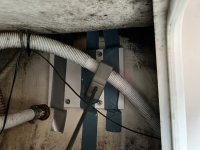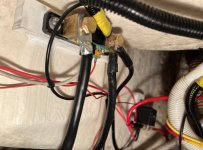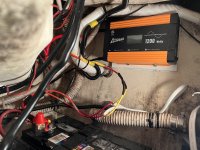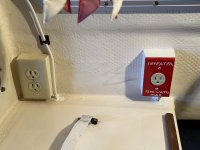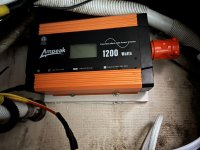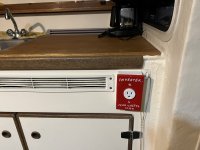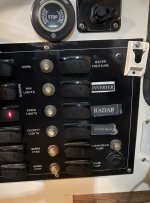thataway
Well-known member
- Joined
- Nov 2, 2003
- Messages
- 21,690
- Reaction score
- 61
- C Dory Year
- 2007
- C Dory Model
- 25 Cruiser
- Hull Identification Number
- DOR25652A707
- Vessel Name
- thataway
A specific answer to Marco Flaminco's question about belts and suspenders. This is a quote from a poster on Trawler Forum, which Marco also frequents.
One of the Major functions of the Battery Management System (BMS) is that it monitors temperatures in the battery (both hot and cold cutoffs). For many the low temp cutoff could be an issue, and a heated battery (which detracts from its full capacity) would be a good choice in AK, or even any latitudes where there is frequent freezing weather.
The below is quoted from Eco-worthy.com:
When we had the Chinese "500 amp" rated switch blow up, the current draw was 300 amps. I was watching the Victron monitor. BMS didn't shut down the batteries, and the 500 amp fuse didn't blow. On the other hand 300 amps is a significant amount of current and other than starting the engine, it is rarely achieved. In this case I had both the microwave and induction burner on "Hi", as a test of the components, as well as preparing to fix dinner. I was using two different 120 volt outlets, each on a 15 amp breaker on the 120 V AC panel (under the aft dinette seat.). I have never done a high current analysis of the starter on the Honda 150 outboard, But the engine start battery was a group 24 FLA battery, My engine was a 2007 and should have the same specs as later Honda 150 battery requirements: 64Ah/5HR 80Ah/20HR. CCA 622. MCA 809. Generally the Honda 150s take somewhere in the 200 to 300 amps to start the 150 outboards. So that is not an unusual load. However if one monitor's the voltage on starting the FLA will often drop to 9 to 11 Volts during this high current draw period. There are some LiFePO4 batteries rated to start engines, but many that application is to be avoided. That is why good policy to have FLA as starting battery, and then the DC to DC charger is running off that FLA start battery.
One test I saw, on on the 100A battery was the high current cut off of the BMS. Specs show 150A, but the battery went to 250A for 30 seconds before shutting down. In the test, the wire got very hot. So, I hope your fuses blows before the wires heats up too much. Not a big deal as long as the fuses are sizes right to each battery and the cables are over sized.
One of the Major functions of the Battery Management System (BMS) is that it monitors temperatures in the battery (both hot and cold cutoffs). For many the low temp cutoff could be an issue, and a heated battery (which detracts from its full capacity) would be a good choice in AK, or even any latitudes where there is frequent freezing weather.
The below is quoted from Eco-worthy.com:
How does BMS work
(1) Monitor the battery
A BMS may monitor the state of the battery and it triggers a power module shutdown if the data is out of range.Monitoring the voltage of each cell is critical to the health of the battery, and lithium-ion battery BMS usually provides each cell with an operating voltage window in charging and discharging to avoid battery degradation.Because lithium battery cells are very sensitive to overcharging and over-discharging, and cells imbalance can lead to thermal runaway and cells degradation.It will decrease the efficiency and short the life span of the battery. Battery cells' operating voltage is between 2.5V and 4.2V depending on the lithium chemistry used. Running the battery beyond this range will result in a significant reduction in battery life and may even damage the battery.
(2) Protect the battery
A Battery Management System (BMS) can monitor and control the charging and discharging process to ensure that the battery stays within its safe operating range.
Overcharge Protection/Overdischarge Protection
BMS estimates the battery's SOC based on voltage and current measurements. This allows the BMS to predict when the battery has reached its current limit and once the battery voltage is above/below the safe limit, the BMS will limit the discharge current or terminate the discharge.
Overvoltage Protection/Undervoltage Protection:
BMS prevents overvoltage/undervoltage by limiting the charging current or stopping the charging process. When the battery's voltage is higher/lower than the safe voltage, the BMS will shut down the charging circuit to prevent damage to the battery.
Temperature Protection
Overcharge and overdischarge can cause the battery temperature to rise or even cause thermal runaway. BMS helps reduce this risk by monitoring battery temperature and taking action when the temperature exceeds its safe operating range.
(3) Short Circuit Protection
The battery management system (BMS) continuously monitors voltage, current and other parameters to prevent short circuit. Faulty wiring will cause short circuit which poses a significant risk to both the battery and the connected device. And BMS can protect the battery from short circuit.
(4) Balance the battery
Unlike lead-acid, the voltage of a fully charged lithium battery rises quickly. If not controlled in time, it may cause battery degradation. There will be a big perform difference between battery cells which may cause the malfunction within the safe voltage range.
TIPS: Battery Cells Consistency (SOC state of charge)
A good battery pack should look like a neat square in a parade, keeping the same rhythm as it moves forward. For example, during the charging process, the charging of other battery cells in the same battery pack must be stopped immediately once a battery cell is fully charged (reaches 100% capacity). Otherwise the battery will be overcharged and cause irreversible damage.
When we had the Chinese "500 amp" rated switch blow up, the current draw was 300 amps. I was watching the Victron monitor. BMS didn't shut down the batteries, and the 500 amp fuse didn't blow. On the other hand 300 amps is a significant amount of current and other than starting the engine, it is rarely achieved. In this case I had both the microwave and induction burner on "Hi", as a test of the components, as well as preparing to fix dinner. I was using two different 120 volt outlets, each on a 15 amp breaker on the 120 V AC panel (under the aft dinette seat.). I have never done a high current analysis of the starter on the Honda 150 outboard, But the engine start battery was a group 24 FLA battery, My engine was a 2007 and should have the same specs as later Honda 150 battery requirements: 64Ah/5HR 80Ah/20HR. CCA 622. MCA 809. Generally the Honda 150s take somewhere in the 200 to 300 amps to start the 150 outboards. So that is not an unusual load. However if one monitor's the voltage on starting the FLA will often drop to 9 to 11 Volts during this high current draw period. There are some LiFePO4 batteries rated to start engines, but many that application is to be avoided. That is why good policy to have FLA as starting battery, and then the DC to DC charger is running off that FLA start battery.

